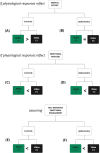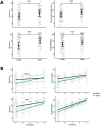Seeing Is Feeling: How Aphantasia Alters Emotional Engagement With Stories
- PMID: 40641144
- PMCID: PMC12246669
- DOI: 10.1111/psyp.70100
Seeing Is Feeling: How Aphantasia Alters Emotional Engagement With Stories
Abstract
Visual imagery is thought to act as an "emotional amplifier," potentially contributing to narrative engagement. To examine this, we conducted two experiments in which participants were presented with emotionally charged audio and video story excerpts. Experiment 1 included 84 online participants from the general population, while Experiment 2 involved 25 individuals with aphantasia (the inability to generate mental images) and 25 controls. In both experiments we assessed narrative engagement behaviorally using the Narrative Engagement Questionnaire (NEQ), while for Experiment 2 we also measured physiological responses. We found a main effect of modality, with video stimuli scoring higher across all NEQ subscales in both experiments. Notably, in experiment 2, a significant group effect on emotional-but not cognitive-engagement emerged, with aphantasics reporting less emotional engagement than controls. Moreover, controls experienced higher heart rate during audio narratives, while aphantasics had a similar heart rate across both modalities. Our results suggest that the enhanced physiological response seen in non-aphantasics during audio narratives is driven by the mental effort required to generate imagery. Furthermore, this capacity for visual imagery appears to enhance emotional engagement with stories. This highlights mental imagery's role in both subjective and physiological responses, emphasizing distinct cognitive processes during narrative engagement.
Keywords: aphantasia; emotional amplifier; narrative engagement; storytelling; visual imagery.
© 2025 The Author(s). Psychophysiology published by Wiley Periodicals LLC on behalf of Society for Psychophysiological Research.
Conflict of interest statement
The authors declare no conflicts of interest.
Figures




Similar articles
-
Education support services for improving school engagement and academic performance of children and adolescents with a chronic health condition.Cochrane Database Syst Rev. 2023 Feb 8;2(2):CD011538. doi: 10.1002/14651858.CD011538.pub2. Cochrane Database Syst Rev. 2023. PMID: 36752365 Free PMC article.
-
Signs and symptoms to determine if a patient presenting in primary care or hospital outpatient settings has COVID-19.Cochrane Database Syst Rev. 2022 May 20;5(5):CD013665. doi: 10.1002/14651858.CD013665.pub3. Cochrane Database Syst Rev. 2022. PMID: 35593186 Free PMC article.
-
Individual variability in mental imagery vividness does not predict perceptual interference with imagery: A replication study of Cui et al. (2007).J Exp Psychol Gen. 2025 Jul;154(7):2043-2057. doi: 10.1037/xge0001756. Epub 2025 May 5. J Exp Psychol Gen. 2025. PMID: 40323864
-
Comparison of self-administered survey questionnaire responses collected using mobile apps versus other methods.Cochrane Database Syst Rev. 2015 Jul 27;2015(7):MR000042. doi: 10.1002/14651858.MR000042.pub2. Cochrane Database Syst Rev. 2015. PMID: 26212714 Free PMC article.
-
Non-pharmacological interventions for sleep promotion in hospitalized children.Cochrane Database Syst Rev. 2022 Jun 15;6(6):CD012908. doi: 10.1002/14651858.CD012908.pub2. Cochrane Database Syst Rev. 2022. PMID: 35703367 Free PMC article.
References
-
- Andreassi, J. L. 2006. Psychophysiology: Human Behavior and Physiological Response. 5th ed. Psychology Press. 10.4324/9780203880340. - DOI
MeSH terms
Grants and funding
LinkOut - more resources
Full Text Sources

